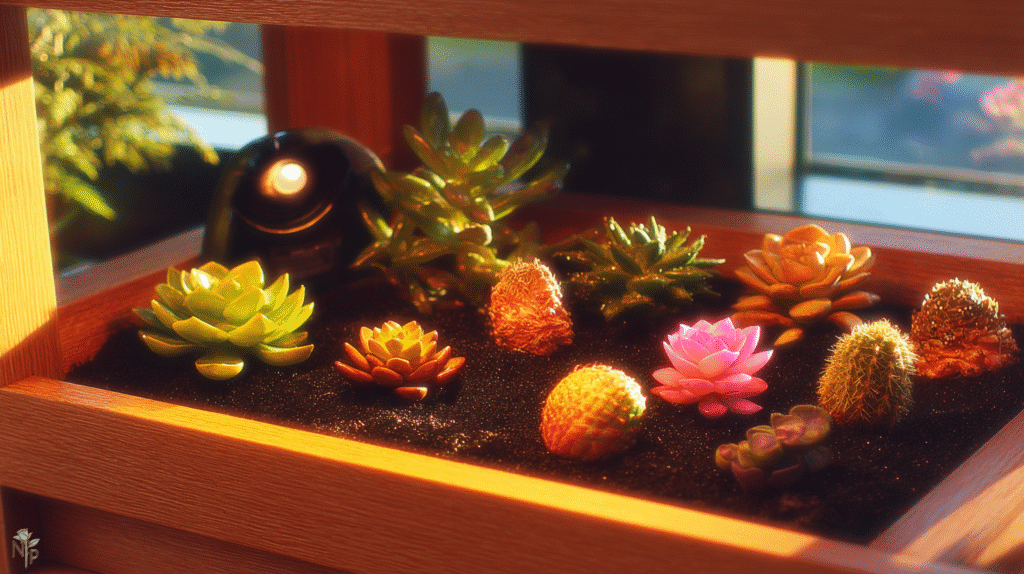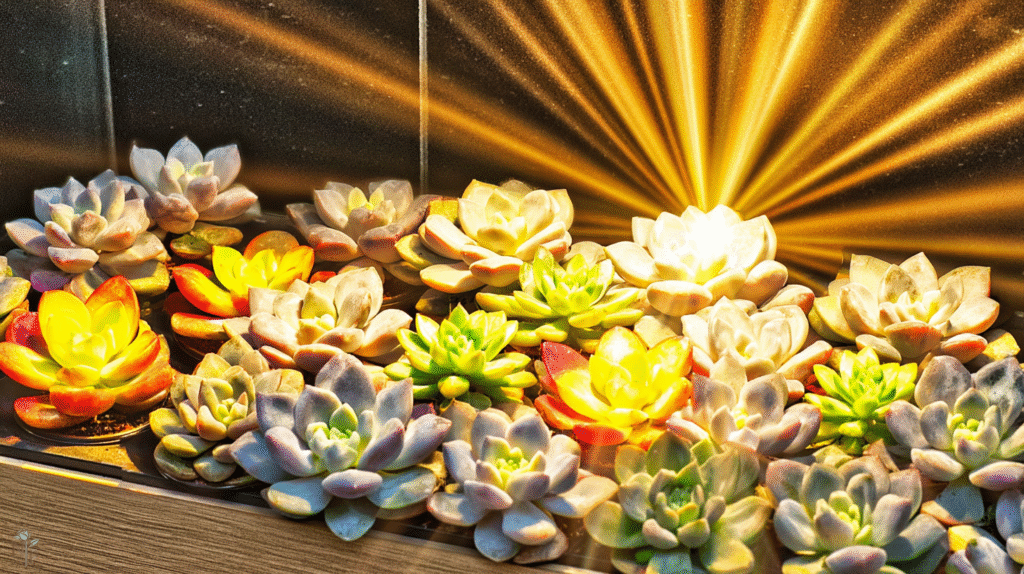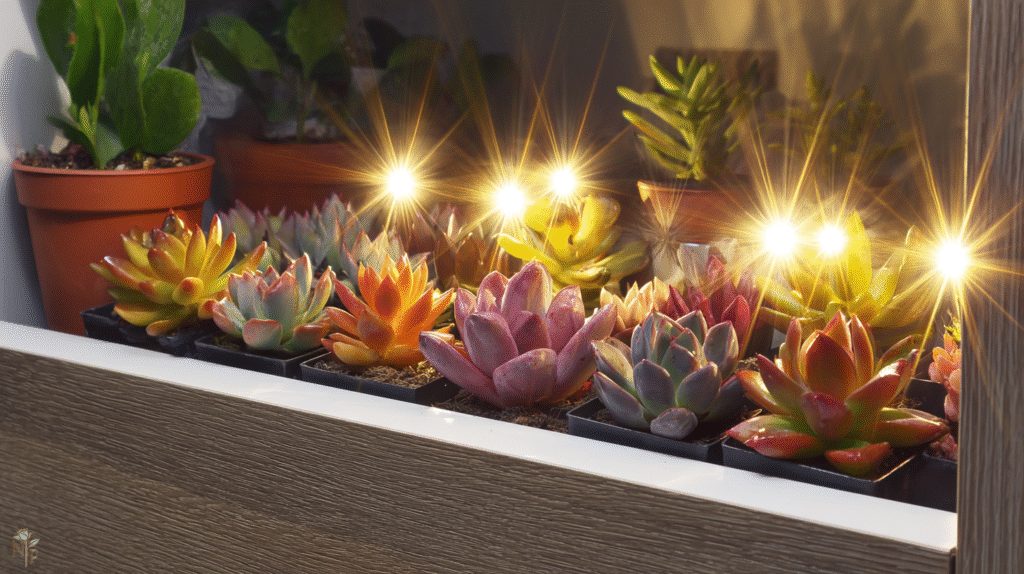My succulent collection looked like a Dr. Seuss illustration gone wrong. Stretched echeverias reaching desperately toward my apartment’s single south-facing window. Jade plants with stems so thin they couldn’t support their own leaves. Everything was green — not the vibrant purples, pinks, and blues I’d been promised on the plant tags.
“Just get a grow light,” everyone said, like it was that simple.
Four returned Amazon purchases and about $250 in various lights later, I finally have succulents that look like the Instagram photos that got me into this mess. Turns out, not all grow lights are created equal, and succulents are surprisingly picky about their artificial suns.
Here’s everything I learned about choosing grow lights that actually work for succulents — not just the ones with five-star reviews from people growing lettuce.
Why Your “Bright” Window Isn’t Bright Enough
Let me blow your mind with some numbers. Succulents in their natural habitat get 50,000-100,000 lux of light. My “bright” south-facing window in winter? About 2,000 lux at noon. On a cloudy day? Maybe 500.
No wonder my plants looked like they were auditioning for a Tim Burton movie.
What succulents actually need:
- Minimum 2,000 foot-candles (about 20,000 lux)
- 12-14 hours of light daily
- Full spectrum including some UV
- Consistent intensity
What windows provide:
- Variable light depending on weather
- Maybe 4-6 hours of decent light
- UV blocked by glass
- Dramatic seasonal changes
My “sun-loving” haworthia in that south window was basically living in a cave by succulent standards.
The Grow Light Types That Actually Work
After my expensive education via returns, here’s what keeps succulents compact and colorful:
Full Spectrum LED Panels
My personal favorite. Using a Spider Farmer SF1000 changed everything. Yes, it looks like I’m growing “herbs.” No, I don’t care anymore.
- True 100W power draw
- Covers 2×2 feet for succulents properly
- Cost: ~$120
- Electric bill increase: ~$8/month
LED Bulbs in Regular Lamps
Perfect for small collections or supplementing window light. Sansi 36W bulbs are my go-to.
- Great for 4-6 plants
- Fits standard fixtures
- Cost: $25-30 each
- Less suspicious looking than panels
T5 HO Fluorescent
Old school but effective for shelving setups.
- Even light distribution
- Good for long, narrow spaces
- Runs warmer (can be good or bad)
- Bulbs need yearly replacement
COB LED Spotlights
Intense, focused light for individual specimens.
- Great for highlighting special plants
- Can achieve stress colors easily
- Risk of burning if too close
- More expensive per coverage area

The Specs That Actually Matter for Succulents
Marketing buzzwords nearly broke my brain. Here’s what your succulents actually care about:
True Wattage vs. “Equivalent”
That “1000W equivalent” usually means 100W actual draw. Always check real power consumption. For succulents:
- 20-30W minimum for a few plants
- 50-100W for a decent collection
- 100W+ for multiple shelves or large areas
Color Temperature
6500K is ideal for growth, but mixing spectrums works better:
- 5000K-6500K for compact growth
- 3000K added for flowering/stress colors
- Full spectrum including red/blue is best
PPFD (The Important Number Nobody Mentions)
Photosynthetic Photon Flux Density — actual light hitting your plants:
- 200-400 μmol/m²/s for most succulents
- 500+ for high light varieties (most echeverias)
- Your window in winter? Maybe 50
Coverage Area Reality
Manufacturers lie. Their “coverage” is for leafy greens, not light-hungry succulents:
- Divide claimed coverage by 3
- Keep lights closer than recommended
- 6-12 inches for most succulents
My Expensive Mistakes (Learn From My Pain)
The Purple Blurple Phase Bought cheap red/blue LEDs because “plants only use those spectrums.” My room looked like a nightclub, couldn’t see true colors, and plants still stretched. Returned after a week of headaches.
The Underpowered Strip Lights Those $20 LED strips with USB plugs? Might as well use a flashlight. Zero impact on growth. Now they light my kitchen cabinets.
The “Great Deal” That Wasn’t “2000W” panel for $35. Actual draw: 65W. Effectively lit about 4 square inches. My succulents laughed at it.
The Distance Disaster Hung my first good light 3 feet above plants because I was paranoid about burning. Result: still stretchy. Succulents want that light CLOSE.
Setting Up Your Lights for Success
Distance from plants:
- LED panels: 12-18 inches
- LED bulbs: 6-12 inches
- T5 fluorescent: 6-10 inches
- Start farther, move closer gradually
Duration (this surprised me):
- 12 hours minimum
- 14-16 hours for best results
- Timer is absolutely essential
- Consistent schedule matters more than perfect duration
Placement tricks:
- Rotate plants weekly (yes, even under lights)
- Put light-hungry varieties directly under
- Haworthias and gasterias on edges
- Use reflective material to maximize coverage

Reading Your Plants’ Light Response
Your succulents will tell you if lighting is right:
Too little light:
- Etiolation (stretching)
- Loss of compact form
- Colors fading to green
- Leaves pointing downward
Just right:
- Compact new growth
- Vibrant colors/stress coloring
- Slight red/purple edges
- Upward-facing leaves
Too much (rare but possible):
- Bleached white spots
- Brown/black burn marks
- Closing up tightly
- Stunted growth
I’ve only achieved “too much” once, and it took serious effort with a COB LED way too close.
My Current Setup Evolution
Started with: One Sansi bulb in a desk lamp Now have: Three-tier wire shelf with:
- Top: Spider Farmer SF1000 for high-light succulents
- Middle: Two T5 fixtures for general collection
- Bottom: Individual COB spots for special specimens
Total investment: ~$400 over two years Dead succulents prevented: Countless Therapy bills saved from plant-related sadness: Priceless
Budget-Friendly Options That Work
Starter setup ($50-80):
- 2 Sansi 24W bulbs
- Clamp lamps from hardware store
- Timer outlet
- Covers 8-10 small plants adequately
Intermediate ($150-200):
- Small quantum board LED (50-100W actual)
- Or 4-foot T5 fixture with bulbs
- Covers a full shelf nicely
Advanced ($300+):
- Full spectrum LED panel(s)
- Multiple timers for different zones
- Light meter to optimize placement
- What my spare bedroom looks like now
The Transformation Timeline
Week 1-2: No visible change. Don’t panic and move lights closer.
Week 3-4: New growth appears more compact. Excitement builds.
Month 2: Colors start developing. Red edges appear.
Month 3: Complete transformation. Etiolated growth obvious compared to new compact growth.
Month 6: You’re shopping for more lights because clearly you need more succulents.
My saddest stretched echeveria ‘Perle von Nurnberg’ went from 8-inch alien tentacle to compact 3-inch rosette in four months under proper lights.
Energy Cost Reality Check
The elephant in the room — electric bills. Here’s my actual increase:
My setup:
- Total ~400W of various lights
- Running 14 hours daily
- Cost increase: ~$25/month
Compared to:
- Constantly buying replacement succulents: $10-30 each
- Seasonal depression from sad plants: Immeasurable
The math makes sense if you’re serious about succulents.

Making the Right Choice for Your Situation
For apartment shelves: T5 or LED panels designed for growing For supplementing windows: Individual LED bulbs in lamps For serious collections: Quantum board LEDs or multiple panels For beginners: Start with one good LED bulb, expand from there
The Bottom Line
That first winter watching my succulents slowly turn into plant noodles almost made me give up the hobby. Now I have a spare bedroom that looks like a commercial grow operation, and I regret nothing.
Start simple — one decent LED bulb can transform a small collection. But be warned: once you see your etiolated succulents develop their true colors and compact forms under proper lighting, you’ll be shopping for bigger lights within months.
The right grow light turns succulent growing from a frustrating exercise in plant stretching to actually achieving those Instagram-worthy rosettes. Your succulents will thank you, your confidence will soar, and your electric bill will… well, let’s focus on the positives. 💡🌵






